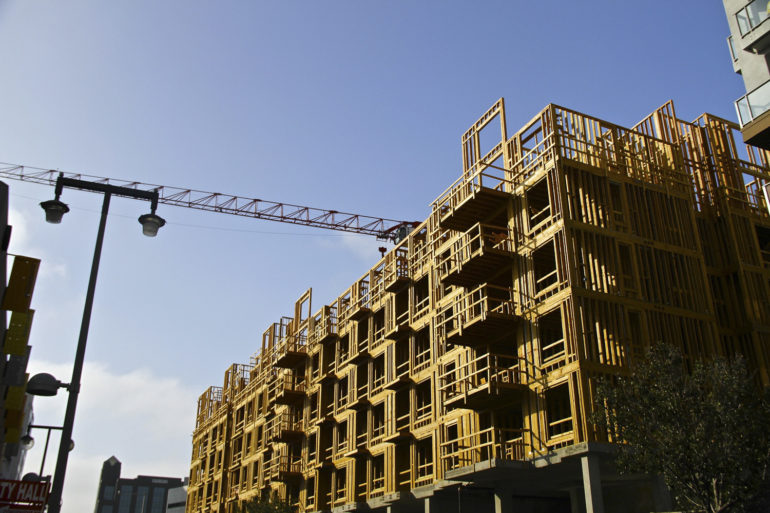In 2016, Angelenos voted to approve Measure HHH, allotting $1.2 billion to build up to 10,000 units of housing plus interim shelters and necessary amenities for unhoused individuals and families. According to a new report from L.A. Controller Ron Galperin, long delays and rising costs have resulted in a pretty pitiful outcome. Basically, everything costs too much and is taking too long. But, he has some suggestions.
According to the report, homelessness increased by 16% in L.A. since last year. And remember, the Greater Los Angeles Homelessness Count was completed before the COVID-19 pandemic and therefore doesn’t reflect the virus’s impact.
At the same time, only three HHH housing projects have opened, accounting for 179 supportive units, which combine housing and services, and 49 non-supportive units. Of the 5,522 supportive units and 1,557 non-supportive units in the pipeline, 73% haven’t even broken ground. Fourteen projects are scheduled to be finished by the end of the year, according to the city’s Housing and Community Investment Department, but many are still in pre-development.
According to Galperin’s report, supportive housing projects typically take between three to six years to build — that’s not even taking into account any COVID-19-related delays. At the current pace, about 80% of all units won’t open until 2022 or later. The cost per unit in pre-development also jumped from $507,000 in 2019 to an average of almost $599,000, while costs for the most expensive units increased from $700,000 to more than $746,000. More than 28% of units under construction exceed $600,000 per unit. According to NBC 4’s “Streets of Shame” segment, that’s more than it costs to build some of the city’s luxury condos.
Why does everything take so long? And why is everything so expensive? Galperin attributed delays — which ranged from 42 days to over a year — to permitting issues, lawsuits and financing complexities.
For example, the shopping center El Mercado de Los Angeles sued to stop a 49-unit project in Boyle Heights. According to Streetsblog LA, the project added all sorts of additional features to appease the city and community, including an on-site YMCA with childcare services available to both residents and the public, before it was finally approved in 2018. This brought the price to $746,000 per unit.
As delays drag on, development costs only increase. HHH money doesn’t cover the entire cost of a project; it makes up a quarter of total development costs across all projects, on average. Construction makes up more than half of each project’s cost, and contracts aren’t executed until funds are assembled, land use issues are resolved, and Proposition HHH loans are closed.
Each developer has two years to get everything in order, and during that time, the cost of materials, such as lumber, can increase. The City could increase its HHH subsidy, but that would likely mean fewer total units overall. As of August 2020, the city has already committed $1.17 billion, mostly to supportive housing projects at an average of $9 million per project.
If any of the “committed” projects should fail, HCIDLA will solicit proposals for new supportive housing projects.
Galperin suggests switching gears and building more interim housing and facilities now while supporting housing units are underway. This would get more people off the streets sooner while also providing access to hygiene, health, sanitation, and storage needs.
Galperin also recommends prioritizing the adaptive reuse of existing buildings, such as hotels, motels and vacant commercial and office spaces.
And it’s not the first time Galperin’s office has suggested thinking about cheaper, faster ways to help people sooner. Measure HHH has always included citizen oversight, plus a yearly audit from the City Controller. Galperin’s office first looked at HHH in October of last year and recommended streamlining permitting and transferring remaining funds to lower-cost projects at that time.
While supportive housing would be ideal, the report notes that even when every single HHH unit is finished and occupied, “tens of thousands of Angelenos will still require housing — highlighting the need for a more strategic and flexible approach to utilizing remaining HHH funds.”
“The issue is not whether the City should invest in supportive housing using HHH funds – the issue is whether the City should almost exclusively pursue an approach that frequently costs more than $600,000 per unit and takes up to six years to complete when there are 29,000 unsheltered Angelenos and an average of three lives lost every day in L.A. County,” the report reads.
In 2019, the City Council set aside $120 million of Proposition HHH funds as an incentive for developers to come up with alternative ways in which subsidized housing is built. The program asked for proposals for 1,000 units outside of the confines of a traditional apartment building. Proposals had to be both faster and cheaper, but also provide long-term, quality housing and connect residents with a homeless agency that could provide services.
Nicholas Halaris, head of the Proposition HHH Citizens Oversight Committee, told the L.A. Times that the units being built as part of this program, which includes modular housing, cost, on average, around $350,000.
“The individuals who run these organizations do not have big, bloated corporate infrastructures but are small with entrepreneurial-driven staff that are not in the business of wasting time or money,” Halaris said.
Galperin’s report shows that the city is in the process of committing $78 million to 562 of these units, but also notes that several of the developers are now pursuing federal tax credits due to delays in state funding, which could result in more time and rising costs. None of these units have begun construction.

